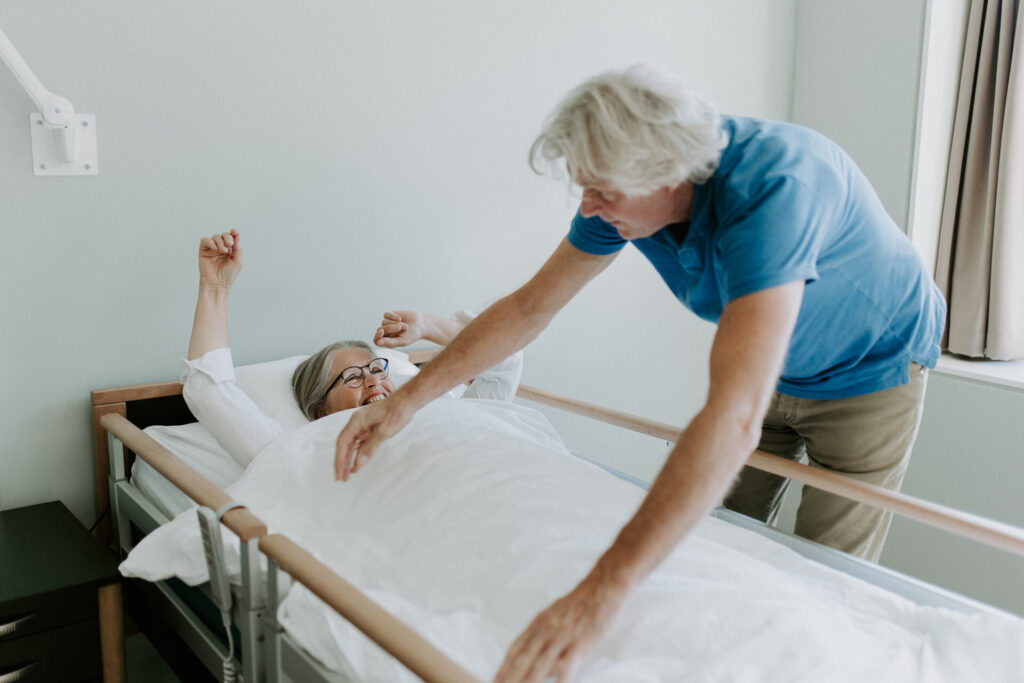Manual turning of patients is a routine task in the healthcare system, but also one of the most resource-intensive. On average, each repositioning requires two employees, and this often happens every two hours – around the clock. With today’s resource shortage in the healthcare system, it is crucial to find smarter and more sustainable solutions.
One option that is getting more and more attention is Tidewave – a mattress with continuous movement that does the job for caregivers. In this article, we compare traditional manual turning with Tidewave, and take a closer look at 5 key benefits – both financially and in terms of quality of life for staff and patients.
1. Resource use and personnel costs
Manual turning requires significant staffing. According to health professionals, an average of 5-10 minutes are spent per turn, and this should happen every 2 hours , around the clock. For one patient, this means up to 12 repositionings a day, and thus up to 2 hours of work per day – just on repositioning.
Costs of manual turning:
-
2 employees per turn × 12 times a day × 5–10 minutes = 2–4 hours per patient per day.
-
At an average cost of EUR 40/hour, this is EUR 80–160 per patient per day.
With Tidewave, the process is automated. The mattress repositions the patient gradually and continuously throughout the night – without the need for manual effort.
|
Activity |
Manual turning |
Tidewave |
|---|---|---|
|
Number of turns/day |
12 |
0 (automatic) |
|
Time spent per day |
2-4 hours |
0 hours |
|
Employees involved |
2 per turn |
0 |
2. Working environment and strain on caregivers
Manual turning is not only time-consuming – it is also physically taxing. Many caregivers report neck, back and shoulder pain, and musculoskeletal disorders are among the most common causes of sick leave in the healthcare sector.
Disadvantages of manual turning:
-
Increased risk of repetitive strain injuries.
-
Higher sickness absence and the use of substitutes.
-
Reduced job satisfaction and higher turnover.
With Tidewave, the caregivers do not have to perform heavy lifting and repetitive movements. This provides a better working environment, fewer sick days and increased well-being.
|
Risk |
Manual Turning |
Tidewave |
|---|---|---|
|
Back/shoulder injuries |
High risk |
Minimal risk |
|
Night work with lifting |
Yes |
No |
|
Sickness absence related to workload |
Frequent |
Reduced |
3. Patient comfort and sleep quality
Frequent manual turns disrupt the patient’s sleep, especially at night. Many patients in need of regular repositioning – such as stroke patients, people with dementia or immobilised people – are woken up regularly, which affects both sleep and recovery.
Tidewave’s solution:
-
Gradual and continuous turning.
-
No need to wake the patient.
-
Increased sleep quality and fewer complications such as pressure ulcers.
The result is that patients sleep better and feel safer, which also reduces the need for medication and supervision.
4. Increased time for care and relationships
When large parts of the caregivers’ time is spent on heavy routine tasks such as turning, there is less time for patient-related care and human contact. Automation through Tidewave frees up valuable time.
Benefits for caregivers:
-
More time for conversations, observation and personal care.
-
Increased focus on prevention rather than firefighting.
-
Better relationship between patient and carer.
In a sector characterised by a fast pace and understaffing, this provides an important boost to both the quality of life of employees and the patients’ experience of care.
5. Financial sustainability in healthcare
Although Tidewave involves an investment cost, the payback time is short. When calculating winnings such as:
-
Reduced need for night shifts
-
Lower sickness absence
-
Fewer pressure ulcers and associated treatment
-
Better use of resources
… the figures show that Tidewave quickly pays off.
Conclusion: Is it time to turn away from manual turning?
Manual turning is an expensive, time-consuming, and burdensome practice – both for the economy and for the people who work in the healthcare system. With automated solutions such as Tidewave , it is possible to increase efficiency, reduce costs and improve quality of life – both for employees and patients.
At a time when the healthcare system is under pressure from all sides, it is not only smart, but also necessary, to invest in technology that solves the heavy tasks and allows people to do what they do best: being present for others.
